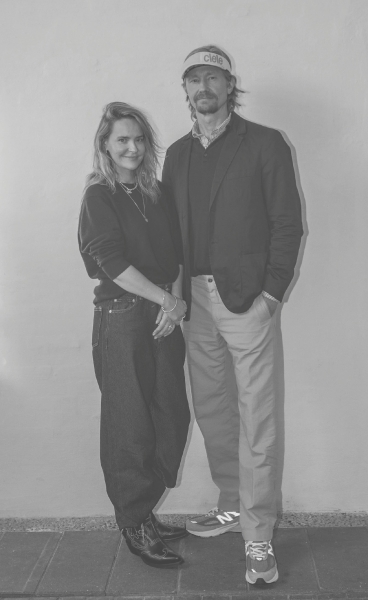
We may earn a commission if you buy something from any affiliate links on our site.
When Ganni founder Nicolaj Reffstrup became keenly aware of fashion’s enormous impact on the planet, he briefly contemplated closing the brand altogether. “I considered if it made sense at all staying in this industry,” he tells Vogue via Zoom from his Copenhagen home. “I ended up concluding that us shutting down Ganni wouldn’t make a dent in anything; nobody would notice. We are a very small fish in the pond, so would rather go out there and do better from a responsibility point of a view than most other [brands] – that’s the thinking that led me to accept my role in this industry.”
It’s Ganni’s journey from cult Scandi favorite to a leader in the sustainability space that’s documented in a new book entitled The Ganni Playbook: How To Get Started Creating A Responsible Business, co-authored by Reffstrup and sustainability journalist Brooke Roberts-Islam. “I’d always thought I’d love to share our learnings with a wider community,” says Reffstrup, who worked in tech before joining the fashion industry. “It’s by no means the perfect playbook for how to run a responsible business, but it’s a contribution.”
Interestingly, Reffstrup prefers the word “responsible” instead of “sustainable”–although he admits that the former is now similarly over-used, and could be considered a cop-out. “The word sustainability for me is something that is circular and balanced, and fashion simply isn’t, no matter how you twist and turn it,” he explains. “But that shouldn’t keep you from taking responsibility. We’re still hoping that one day we will get to a point when we can talk about a sustainable fashion industry.”

In many ways, the book shows how much Ganni’s transformation in recent years has been driven by Reffstrup’s personal values. “The thing about Nicolaj is that you can’t divorce the business strategy with the person,” Roberts-Islam remarks. “Maybe it’s as simple as some people care and they can’t help caring, and other people don’t.”
It’s why sustainability (or responsibility) is embedded throughout the company, from the oyster mushrooms grown from coffee grounds in its canteen, designed to inspire staff, to the “carbon squad” made up of 19 volunteers across the business, who act as ambassadors for its carbon reduction strategy. Crucially, these values are also at the core of everything the design team–led by Ganni’s creative director, and Reffstrup’s wife, Ditte–does. “It all starts and ends with the product, because the product is the majority of our carbon footprint, right?” Reffstrup notes.
Indeed, materials alone are responsible for 58 per cent of Ganni’s total carbon emissions, which is why the brand has set a goal of using 90 per cent “preferred materials”, such as organic and recycled cotton, recycled polyester and recycled wool, by 2025. The brand hopes the other 10 per cent will be made up of new materials from its Fabrics of the Future initiative, which has seen the brand adopt an array of innovations, from leather alternatives made out of orange and cactus waste to bacteria-grown leather. Not all have been successful: Mylo, an alternative leather made from mushroom roots, ceased production last year, while Renewcell, which created a material made from 100 per cent textiles waste, filed for bankruptcy in February.

These are risks that Reffstrup is willing to take in his desire for Ganni to push the envelope. Case in point: the brand’s commitment to eliminate virgin leather from its designs – a goal it successfully achieved at the end of last year – after discovering that it was responsible for a third of its carbon footprint from materials, despite only making up nine per cent of its collections. This has led to some hard decisions: the brand has had to discontinue (at least for now) two color ways of its best-selling Western boots as it can’t currently find a way of producing them without using virgin leather–costing the company an estimated 2.4 million DKK (roughly $349,000) in sales.
While, refreshingly, the topline may not be everything at Ganni, Reffstrup is clear that the company does need to grow in order for it to continue to invest in sustainable solutions. The challenge? Ensuring that this growth doesn’t cancel out its ambitious goal of slashing its absolute greenhouse gas emissions by half by 2027, compared to 2021 (currently, the majority of fashion’s climate targets are in relation to growth, meaning that if they sell more products, their greenhouse gas emissions could increase in real terms). In positive news, the brand’s latest responsibility report found that emissions did drop seven per cent in 2023, despite the company growing on average 18 per cent in the past three years.
Still, there’s a long way to go in order for the brand to achieve its target. “Phasing out virgin leather entirely will have a substantial impact on 2024 reporting, so I’m confident we will continue the trend [of reducing emissions],” Reffstrup says. “Looking beyond that, we need a lot of innovative new materials, more circular business models, take-back schemes, better recycling of our own product – so lots of unknown factors.”
Ganni’s approach shows that change is possible, even if we don’t currently have all the answers – which is why Reffstrup hopes his book will inspire other fashion brands to embark on this journey, too. “I’m hoping for action over perfection – just go out there and do something,” he urges.
The Ganni Playbook: How To Get Started Creating A Responsible Business will be available from Ganni.com on June 12 and globally from June 27.

